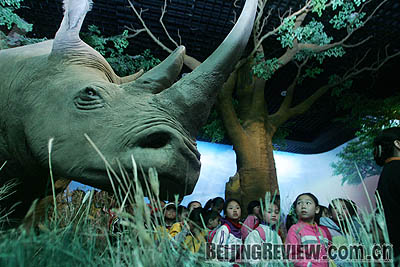| 
ABSOLUTELY CHARMING: Children file past a rhinoceros in an exhibition called the Charm of Animals at Beijing Museum of Natural History in April
Beijing Museum of Natural History is located in Chongwen District, close to the Temple of Heaven and Tianqiao Theater. It was founded in 1951 and formally named Beijing Museum of Natural History in 1962.
The museum occupies 12,000 square meters, more than 8,000 square meters of which is for display. It bears three main functions: specimen collection, academic research and the popularization of paleontology, zoology, botany and anthropology. It was the first museum of natural history founded by China after the founding of the People's Republic of China in 1949. Today it is the most popular natural history museum in the country with more than 200,000 items, including a collection of paleontology, ornithology, mammals and invertebrates. It is one of a few museums of natural history in China and has now been named a National Youth Science and Technology Education Base.
The large-scale paleontology exhibition, opened in August 2003, consists of four galleries on the Origin of Life and Early Evolution, the Prosperity of Invertebrates, the Evolution of Dinosaurs and the Evolution of Mammals. With many exquisite fossils perfectly combined with modern hi-tech display techniques, the exhibition vividly shows the process of evolution from primal to evolutional, from primitive to advanced, and from simple to complex through the geological eras.
Tian Jiabing Building, where the specimens are housed, was constructed with a donation from Tian Jiabing, a businessman from Hong Kong, and money from the Beijing Municipal Government. Covering an area of 3,600 square meters, it is the largest museum building of this kind with the best equipment in China. The museum owns 200,000 specimens ranging from zoology, botany and paleontology to anthropology, some of which rank as rarities both in China and all over the world.
The museum has a group of experts involved in the research on zoology, botany, paleontology and anthropology. They collect specimens for research that is recognized worldwide.
In 1979, the museum initiated the Chinese Association of Natural Science Museums with the purpose to enhance the communication among the natural science museums all over China. This association, which is based at the museum together with Beijing Society of Zoology and Beijing Society of Botany, plays an increasingly important role in the museum field. |
